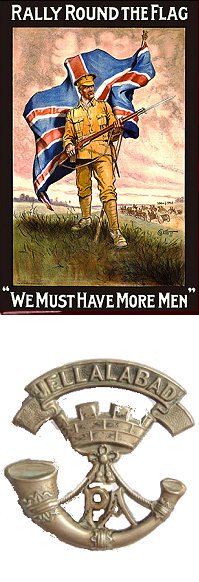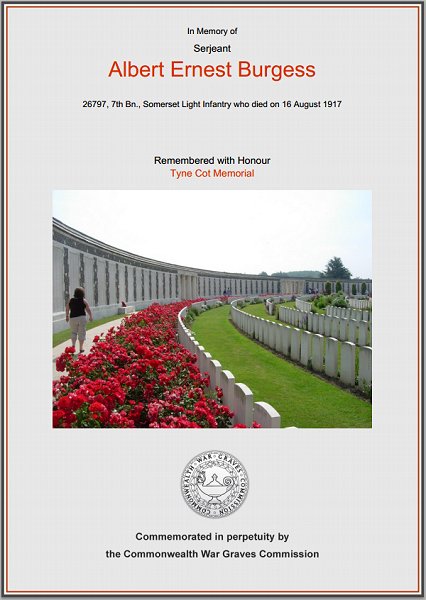yeovil at War
Albert Ernest Burgess
Killed at the Battle of Langemarck
Very little is known about Albert Ernest Burgess although, since his name is given as E Burgess on the War Memorial in the Borough, it is likely that he was known as Ernest. He was born in Bath in 1885 and married Lilian ES Ricketts in Bath in the summer of 1913. They had two children. And that, in a nutshell, is all I could find out about him. He is known to have been a postman in Yeovil but that must have been in the year or two before the outbreak of war.
 He
enlisted in the
army at Bath,
apparently
around 1913, on
a three-year
service and was
a National
Reservist at the
outbreak of war.
As a consequence
he was called up
immediately in
August 1914 (and
is probably in
the first
photograph below
of the National
Reservists in
the
Borough).
Whether or not
he was in the
Somerset Light
Infantry for his
pre-war service
is not known,
although his
Service Number
26797 would
suggest that he
was.
He
enlisted in the
army at Bath,
apparently
around 1913, on
a three-year
service and was
a National
Reservist at the
outbreak of war.
As a consequence
he was called up
immediately in
August 1914 (and
is probably in
the first
photograph below
of the National
Reservists in
the
Borough).
Whether or not
he was in the
Somerset Light
Infantry for his
pre-war service
is not known,
although his
Service Number
26797 would
suggest that he
was.
It is likely that he was in the 1st Battalion of the Somerset Light Infantry. Quickly promoted he spent several months in France before being discharged as time-expired, probably during the summer of 1916. He would ultimately be promoted to Sergeant.
At the outbreak of war in 1914 the 1st Battalion was in Colchester, with 11th Brigade, 4th Division. The Battalion landed at Le Havre, France with the British Expeditionary Force (BEF) on 22 August 1914, in time to fight in the battle of Le Cateau during the retreat from Mons. The 1st Battalion, Somerset Light Infantry remained on the Western Front with 4th Division, throughout the war, suffering 1,315 losses.
In 1914 the 1st Battalion saw action at the Battle of the Marne, the Battle of the Aisne and at the Battle of Messines.
The First Battle of the Marne, fought from 5 to 12 September 1914, resulted in an Allied victory against the German Army. The battle was the culmination of the German advance into France and pursuit of the Allied armies which followed the Battle of the Frontiers in August, which had reached the outskirts of Paris. The counterattack of six French field armies and the British Expeditionary Force (BEF) along the Marne River forced the German Imperial Army to abandon its push on Paris and retreat north-east, leading to the 'Race to the Sea' and setting the stage for four years of trench warfare on the Western Front. The Battle of the Marne was an immense strategic victory for the Allies, wrecking Germany's bid for a swift victory over France and forcing it into a drawn-out two-front war.
The First Battle of the Aisne was the Allied follow-up offensive against the right wing of the German First and Second Armies as they retreated after the First Battle of the Marne earlier in September 1914. The offensive began on the evening of 13 September, after a hasty pursuit of the Germans. When the Germans turned to face the pursuing Allies on 13 September, they held one of the most formidable positions on the Western Front. Low crops in the unfenced countryside offered no natural concealment to the Allies but deep, narrow paths cut into the escarpment at right angles, exposing any infiltrators to extreme hazard. In dense fog on the night of 13 September, most of the BEF crossed the Aisne on pontoons or partially demolished bridges. Under the thick cover of the foggy night, the BEF advanced up the narrow paths to the plateau. When the mist evaporated under a bright morning sun, they were mercilessly raked by fire from the flank. Those caught in the valley without the fog's protective shroud fared no better. It soon became clear that neither side could budge the other and since neither chose to retreat, the impasse hardened into stalemate that would lock the antagonists into a relatively narrow strip for the next four years.
The Battle of Messines, fought between 12 October and 2 November 1914, was part of the 'Race to the Sea', the series of battles that decided the line of the Western Front. In the aftermath of the first Battle of the Marne, it was decided to move the BEF back north to Flanders, to shorten its supply lines back to the channel ports. The Battle of Messines was the official name for the fighting between the river Douve and the Comines-Ypres canal, but it merged into the battle of Armentières to the south and the first battle of Ypres to the north.
In 1915 the 1st Battalion, Somerset Light Infantry fought in the Second Battle of Ypres.
The Second Battle of Ypres, 22 April-25 May 1915, was a rare German offensive on the Western Front during 1915. It was launched with two aims in mind. The first was to distract attention from the movement of German troops to the eastern front in preparation for the campaign that would lead to the victory of Gorlice-Tarnow. The second was to assess the impact of poisoned gas on the western front. Gas had already been used on the eastern front, at Bolimov (3 January 1915), but the tear gas used there had frozen in the extreme cold. At Ypres the Germans used the first lethal gas of the war, chlorine. The gas was to be released from 6,000 cylinders and would rely on the wind to blow it over the allied trenches. This method of delivery controlled the timing of the attack – the prevailing winds on the western front came from the west, so the Germans had to wait for a suitable wind from the east to launch their attack. The line around Ypres was held by French, Canadian and British troops. The attack on 22 April hit the French lines worst and, not surprisingly, the line broke under the impact of this deadly new weapon. The gas created a gap 8,000 yards long in the Allied lines north of Ypres. The success of their gas had surprised the Germans who didn’t have the reserves to quickly exploit the unexpected breakthrough, allowing enough time to plug the gap with newly arrived Canadian troops. During the battle the British, French and Canadians suffered 60,000 casualties, the Germans only 35,000.
In 1916 the 1st Battalion moved south and were in action during the Battles of the Somme. However it is likely that Albert's three year term of service was up during this period and he probably returned home to England during the autumn of 1916. Nevertheless he was called up again, probably in 1917. This time he joined the 7th (Service) Battalion of the Somerset Light Infantry and was sent to France yet again.
He endured several more months of trench warfare in the Ypres area of Belgium. His last action was the Battle of Langemarck.
The Battle of Langemarck from 16 to 18 August 1917, was the second Allied general attack of the Third Battle of Ypres. The Allied attack succeeded in the north, from Langemarck to Drie Grachten ("Three Canals") but early advances in the south on the Gheluvelt Plateau were forced back by powerful German counter-attacks. Both sides were hampered by rain, which had a greater effect on the British who occupied lower-lying areas and advanced onto ground which had been frequently and severely bombarded.
The diary of the 7th Somersets for 15 August reads "Battalion in front line in front of Langemarck, waiting to attack." The Regimental History of the Somerset Light Infantry continues "The night of the15th / 16th of August was spent in making final preparations. The attacking troops had to be in position on the Sitenbeek an hour before Zero, which had been fixed for 4:45am. Of the 7th Somersets, A Company, on the right, and D Company on the left, were to form the first wave. In darkness these two Companies set out to take over the outpost line from the 11th Rifle Brigade. They had to cross the flooded stream, whose banks were boggy and slippery with slimy mud. The garrisons of the posts on the eastern bank had only been able to push forward about 75 yards from the bank and in that limited space the leading Battalions had to form up for the attack. B Company, on the right, and C Company on the left, formed the second wave of the 7th Somerset Light Infantry. Immediately on reaching their allotted positions all companies dug themselves in, and while this work was in progress the enemy frequently sent up Véry lights....
At 4:45am the creeping barrage fell with great precision on the enemies shell-a whole posts, and all along the line the advance began.... Men were continually stuck fast in the mud and had to pull each other out, the wild, under a galling machine gun fire from a line of concrete emplacements (pillboxes) near Reitres Farm: here the advance was checked. The check lasted 14 to 15 minutes and during that time casualties were heavy....
At Zero plus 50 minutes (5:35am) B and C Companies left the Blue Line and followed the barrage right through the village.... Heavy machine gun fire, again from concrete buildings at the north-west end of the village, met the advance of these two Companies, who were also worried by hostile snipers from the right flank. Snipers from both Companies, however, were told off to deal with the enemy and, having reduced their activities to nil, B and C organised an attack on the front of the concrete buildings. Both Companies sent forward parties of bombers, under cover of Lewis-gun fire, and very soon the enemies of offensive was broken down, one German officer and 30 men surrendering. The next stronghold was dealt with in a similar manner, bombing parties working forward from shell hole to shell hole, finally bombing the enemy out of his stronghold. 40 more prisoners and four machine guns were captured their this last operation effectively cleared the village and no further opposition was met with."
Sadly Albert Ernest Burgess was killed during this attack of 16 August 1917. He was aged 32.
On 31 August 1917 the Western Gazette reported "Unofficial information has been received that Sergeant E Burgess, of the Somerset Light Infantry has been killed in action whilst serving in France. Prior to enlisting, the non-commissioned officer was a respected local postman, and is well-known in Yeovil. An Army Reservist, he was called to the Colours on almost the initial day of the war, and he soon received a promotion, till ultimately he held his present rank. After many months of active service in France, he was temporarily discharged from the service, being time expired, but he soon received another call to rejoin the Forces, and, after several months further active service, news of his death has been received from a local soldier now serving with the Somersets in France. Profound sympathy has been extended to the wife and two young children."
Albert Ernest Burgess is commemorated on Panels 41 to 42 and 163A of the Tyne Cot Memorial and his name is inscribed on the War Memorial in the Borough - albeit as Burgess, E rather than the correct form Burgess, AE.
Other Yeovil
lads killed on
this day include
-
Harold Dicks,
Frederick Hunt,
Robert Fry
and
Alfred Tuck.
gallery

The Commonwealth War Graves Commission certificate in memory of Albert Ernest Burgess.